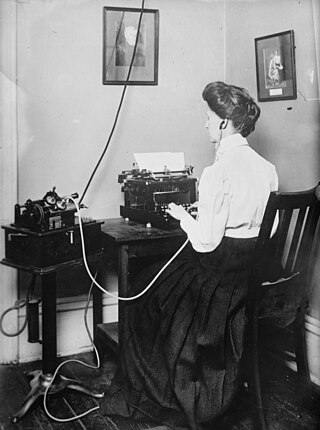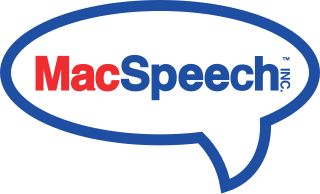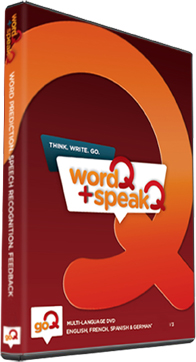Related Research Articles
Speech recognition is an interdisciplinary subfield of computer science and computational linguistics that develops methodologies and technologies that enable the recognition and translation of spoken language into text by computers. It is also known as automatic speech recognition (ASR), computer speech recognition or speech-to-text (STT). It incorporates knowledge and research in the computer science, linguistics and computer engineering fields. The reverse process is speech synthesis.

Dictaphone was an American company founded by Alexander Graham Bell that produced dictation machines. It is now a division of Nuance Communications, based in Burlington, Massachusetts.
IBM ViaVoice was a range of language-specific continuous speech recognition software products offered by IBM. The current version is designed primarily for use in embedded devices. The latest stable version of IBM Via Voice was 9.0 and was able to transfer text directly into Microsoft Word.
PlainTalk is the collective name for several speech synthesis (MacinTalk) and speech recognition technologies developed by Apple Inc. In 1990, Apple invested a lot of work and money in speech recognition technology, hiring many researchers in the field. The result was "PlainTalk", released with the AV models in the Macintosh Quadra series from 1993. It was made a standard system component in System 7.1.2, and has since been shipped on all PowerPC and some 68k Macintoshes.

Microsoft Office XP is an office suite which was officially revealed in July 2000 by Microsoft for the Windows operating system. Office XP was released to manufacturing on March 5, 2001, and was later made available to retail on May 31, 2001. A Mac OS X equivalent, Microsoft Office v. X was released on November 19, 2001.

MacSpeech, Inc. was a New Hampshire-based technology company that produced software-based speech recognition and voice dictation solutions for the Apple ecosystem. The company's products included iListen, MacSpeech Dictate, MacSpeech Dictate Medical, MacSpeech Dictate Legal, MacSpeech Dictate International, and MacSpeech Scribe. On February 12, 2010, Nuance Communications, Inc. acquired MacSpeech.

Dragon NaturallySpeaking is a speech recognition software package developed by Dragon Systems of Newton, Massachusetts, which was acquired in turn by Lernout & Hauspie Speech Products, Nuance Communications, and Microsoft. It runs on Windows personal computers. Version 15, which supports 32-bit and 64-bit editions of Windows 7, 8 and 10, was released in August 2016.
A voice-user interface (VUI) enables spoken human interaction with computers, using speech recognition to understand spoken commands and answer questions, and typically text to speech to play a reply. A voice command device is a device controlled with a voice user interface.
Medical transcription, also known as MT, is an allied health profession dealing with the process of transcribing voice-recorded medical reports that are dictated by physicians, nurses and other healthcare practitioners. Medical reports can be voice files, notes taken during a lecture, or other spoken material. These are dictated over the phone or uploaded digitally via the Internet or through smart phone apps.
iListen, developed by MacSpeech, is a speech recognition program for the Apple Macintosh. In 2006, iListen was the only third-party software that allowed inputting text using one's voice that works on newer Macintosh models. Its competitors were Apple's own speech recognition software ; Dragon Naturally Speaking by Nuance, running under Windows virtualization software such as Parallels Desktop for Mac or VMware Fusion; and the discontinued speech recognition program ViaVoice by Nuance/IBM.
As of the early 2000s, several speech recognition (SR) software packages exist for Linux. Some of them are free and open-source software and others are proprietary software. Speech recognition usually refers to software that attempts to distinguish thousands of words in a human language. Voice control may refer to software used for communicating operational commands to a computer.

Windows Speech Recognition (WSR) is speech recognition developed by Microsoft for Windows Vista that enables voice commands to control the desktop user interface, dictate text in electronic documents and email, navigate websites, perform keyboard shortcuts, and operate the mouse cursor. It supports custom macros to perform additional or supplementary tasks.
Swype was a virtual keyboard for touchscreen smartphones and tablets originally developed by Swype Inc., founded in 2002, where the user enters words by sliding a finger or stylus from the first letter of a word to its last letter, lifting only between words. It uses error-correction algorithms and a language model to guess the intended word. It also includes a predictive text system, handwriting and speech recognition support. Swype was first commercially available on the Samsung Omnia II running Windows Mobile, and was originally pre-loaded on specific devices.
The Voice Navigator was the first voice recognition device for command and control of a graphical user interface. The system was developed by Articulate Systems, Inc. originally designed for the Apple Macintosh Plus and released in 1989. Subsequent versions were created for Microsoft Windows. Articulate Systems, Inc. was acquired by Dragon Systems in 1998.
MacSpeech Scribe is speech recognition software for Mac OS X designed specifically for transcription of recorded voice dictation. It runs on Mac OS X 10.6 Snow Leopard. The software transcribes dictation recorded by an individual speaker. Typically, the speaker will record their dictation using a digital recording device such as a handheld digital recorder, mobile smartphone, or desktop or laptop computer with a suitable microphone. MacSpeech Scribe supports specific audio file formats for recorded dictation: .aif, .aiff, .wav, .mp4, .m4a, and .m4v.
Dragon Dictation started as speech recognition application for Apple's iOS platforms, including iPhone, iPod Touch and iPad. The app provided automatic speech-to-text capabilities. It was developed by Nuance Communications, and released in December 2009 as a free app. It is now commonly found licensed in vehicle infotainment systems and healthcare equipment.

WordQ® is an assistive technology software developed by Quillsoft Ltd. and Holland Bloorview Kids Rehabilitation Hospital. WordQ's main purpose is helping individuals who struggle with reading and writing. Often that struggle is due to physical disability or neurodivergence such as Dyslexia or ADHD. WordQ uses intelligent word prediction to suggest words that the user is typing in as few as 1.3 keystrokes. This helps with spelling, and reduces the amount of physical movements a user has to make when typing. It also uses high-quality Acapela text-to-speech voices to read back text that the user has entered, allowing for proofreading and editing. WordQs speech recognition feature, SpeakQ®, is included in WordQ Desktop for Windows OS. It allows users to switch between speaking and typing while writing. WordQ Desktop is available for Windows and Mac OS, iWordQ is available for iPadOS, and WordQ Chrome for the Chrome browser is slated for release in January 2022.

Braina is a virtual assistant and speech-to-text dictation application for Microsoft Windows developed by Brainasoft. Braina uses natural language interface, speech synthesis, and speech recognition technology to interact with its users and allows them to use natural language sentences to perform various tasks on a computer. The name Braina is a short form of "Brain Artificial".
Michael Phillips is the CEO and co-founder of Sense Labs and a pioneer in machine learning, including mobile speech recognition and text-to-speech technology.
References
- ↑ Nuance - Dragon for Mac
- ↑ Finally, Professional Dictation Software for the Mac David Pogue, September 23, 2010
- ↑ Mac users burned after Nuance drops Dragon speech to text software October 30, 2018
- ↑ David, Kathleen (January 15, 2013). "Your Semi Daily Peter David Report for Jan 15 2012". peterdavid.net.
- ↑ "Peter David, Post-Stroke, Returns Home". startrek.com. February 11, 2013.